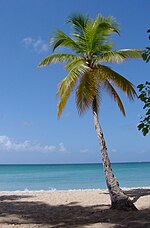Salacca
| Salacca | |
|---|---|

| |
| Salacca zalacca fruit | |
| Scientific classification | |
| Kingdom: | Plantae |
| Clade: | Tracheophytes |
| Clade: | Angiosperms |
| Clade: | Monocots |
| Clade: | Commelinids |
| Order: | Arecales |
| Family: | Arecaceae |
| Subfamily: | Calamoideae |
| Tribe: | Calameae |
| Genus: | Salacca Reinw. |
| Synonyms[1] | |
| |
Salacca is a genus of about 20 species of palms native to Southeast Asia and the eastern Himalayas.[1][2] They are dioecious (with the exception of Salak Bali) and pollinated by Curculionidae beetles.[3]
They are very short-stemmed palms, with leaves up to 6–8 m long. The leaves have a spiny petiole; in most species they are pinnate with numerous leaflets, but some species, notably S. magnifica, have undivided leaves. The fruit grow in clusters at the base of the plants, and are edible in many species, with a reddish-brown scaly skin covering a white pulp and one to two large inedible seeds. The Salak (S. zalacca) or snake fruit is the species most widely grown for its fruit; the firm white pulp has a slight acidic taste. The skin of the snakefruit has a unique texture not unlike that of a snake's skin, rough to the touch in one direction but smooth in the other.
Species
[edit]
- Salacca acehensis Chikmawati. - Aceh
- Salacca affinis Griff. - Borneo, Sumatra, Malaysia
- Salacca bakeriana J.Dransf. - Sarawak
- Salacca clemensiana Becc. - Borneo, Philippines
- Salacca dolicholepis Burret - Sabah
- Salacca dransfieldiana Mogea - Kalimantan
- Salacca flabellata Furtado - Malaysia
- Salacca glabrescens Griff. - Malaysia, Thailand
- Salacca graciliflora Mogea - Malaysia
- Salacca griffithii A.J.Hend. - Yunnan, Myanmar, Thailand
- Salacca lophospatha J.Dransf. & Mogea - Sabah - apparently extinct
- Salacca magnifica Mogea - Sabah
- Salacca minuta Mogea - Malaysia
- Salacca multiflora Mogea - Malaysia
- Salacca ramosiana Mogea - Sabah, Philippines
- Salacca rupicola J.Dransf. - Sarawak
- Salacca sarawakensis Mogea - Sarawak
- Salacca secunda Griff. - Assam, Bhutan, Arunachal Pradesh, Myanmar
- Salacca stolonifera Hodel - Thailand
- Salacca sumatrana Becc. - Sumatra
- Salacca vermicularis Becc. - Borneo
- Salacca wallichiana Mart. - Malaysia, Thailand, Myanmar, Sumatra
- Salacca zalacca (Gaertn.) Voss - Java, Sumatra; naturalized in Bali, Lombok, Timor, Malaysia, Maluku, Philippines, Sulawesi
References
[edit]- ^ a b "World Checklist of Selected Plant Families: Royal Botanic Gardens, Kew". apps.kew.org. Retrieved 14 March 2018.
- ^ Govaerts, R. & Dransfield, J. (2005). World Checklist of Palms: 1-223. The Board of Trustees of the Royal Botanic Gardens, Kew.
- ^ MATSUDA, Hiroshi; HIGUCHI, Hirokazu; MIYAJI, Naoki; OKABE, Masanori (2020). "Liquid Spray Pollination in Salak (Salacca wallichiana C. Mart.)". Tropical Agriculture and Development. 64. doi:10.11248/jsta.64.153.
